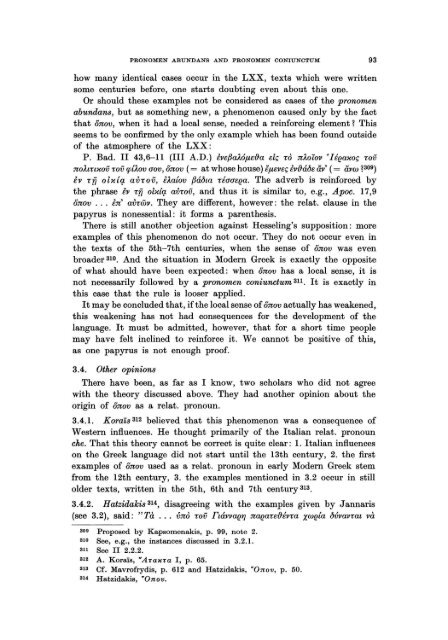Pronomen Abundans and Pronomen Coniunctum. A ... - DWC
Pronomen Abundans and Pronomen Coniunctum. A ... - DWC
Pronomen Abundans and Pronomen Coniunctum. A ... - DWC
You also want an ePaper? Increase the reach of your titles
YUMPU automatically turns print PDFs into web optimized ePapers that Google loves.
PRONOMEN ABUNDANS AND PRONOMEN CONIUNCTUM 93<br />
how many identical cases occur in the LXX, texts which were written<br />
some centuries before, one starts doubting even ab out this one.<br />
Or should these examples not be considered as cases of the pronomen<br />
abundans, but as something new, a phenomenon caused only by the fact<br />
that önov, when it had alocal sense, needed a reinforcing element? This<br />
seems to be confirmed by the only example which has been found outside<br />
of the atmosphere of the LXX :<br />
P. Bad. II 43,6-11 (lIl A.D.) ÈvefJaAófld)a elç ia nAolov 'Ueaxoç ioiJ<br />
nOAtTtXoiJ ioiJ g;lAov aov, önov (= at whose house) Ëfleveç Èv{)áfJe uv' (= uvw P09)<br />
Èv in olxlq. aVioiJ, lAalov fJát5w Tiaaeea. The adverb is reinforced by<br />
the phrase Èv in olxlq. aVioiJ, <strong>and</strong> thus it is similar to, e.g., Apoc. 17,9<br />
önov . .. Èn' avnóv. They are different, however: the relat. clause in the<br />
papyrus is nonessential : it forms a parenthesis.<br />
There is still another objection against Hesseling's supposition: more<br />
examples of this phenomenon do not occur. They do not occur even in<br />
the texts of the 5th-7th centuries, when the sen se of önov was even<br />
broader 310. And the situ at ion in Modern Greek is exactly the opposite<br />
of what should have been expected: when önov has alocal sense, it is<br />
not necessarily followed by a pronomen coniunctum 311 . It is exactly in<br />
this case that the rule is looser applied.<br />
It may be concluded that, ifthe local sense of önov actually has weakened,<br />
this weakening has not had consequences for the development of the<br />
language. It must be admitted, however, that for a short time people<br />
may have feIt inclined to reinforce it. We cannot be positive of this,<br />
as one papyrus is not enough proof.<br />
3.4. Other opinions<br />
There have been, as far as I know, two scholars who did not agree<br />
with the theory discussed above. They had another opinion about the<br />
origin of önov as arelat. pronoun.<br />
3.4.1. Koraïs 312 believed that this phenomenon was a consequence of<br />
Western influences. He thought primarily of the Italian relat. pronoun<br />
che. That this theory cannot be correct is quite clear : 1. Italian influences<br />
on the Greek language did not start until the 13th century, 2. the first<br />
ex am pIes of önov used as arelat. pronoun in early Modern Greek stem<br />
from the 12th century, 3. the examples mentioned in 3.2 occur in still<br />
older texts, written in the 5th, 6th <strong>and</strong> 7th century 313.<br />
3.4.2. Hatzidakis 314, disagreeing with the examples given by Jannaris<br />
(see 3.2), said: "Tà ... vna ioiJ Ftávvae'YJ naeau{)évTa xwela t5vvav-rat và<br />
309 Proposed by Kapsomenakis, p . 99, note 2.<br />
310 See, e.g., the instanees discussed in 3.2.1.<br />
311 See II 2.2.2.<br />
312 A. Koraïs, "ATa~Ta I, p. 65.<br />
313 Cf. Mavrofrydis, p . 612 <strong>and</strong> Hatzidakis, no 1l0V, p . 50.<br />
314 Hatzidakis, ·01lov.
















